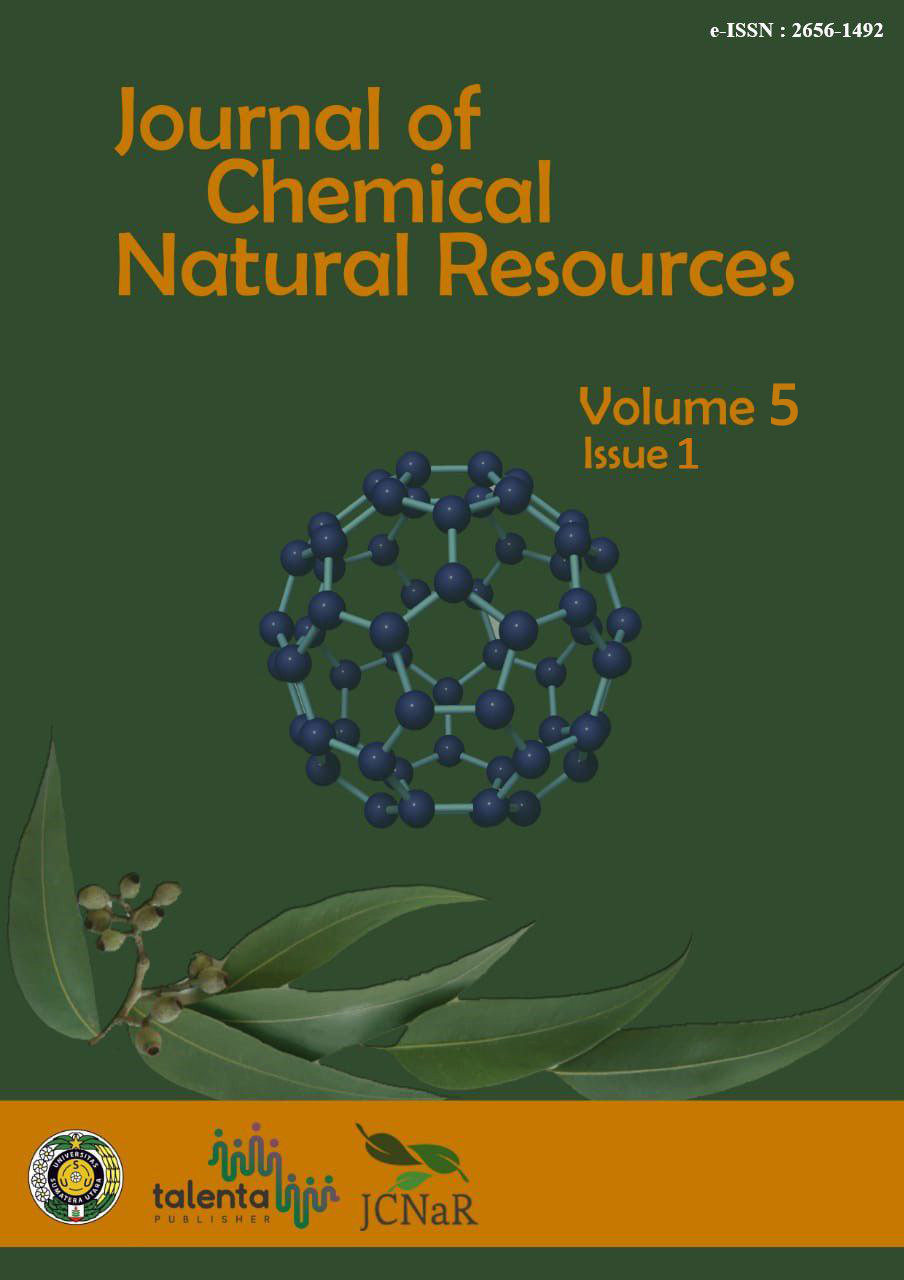Synthesis of Schiff's Base Between Dialdehid Alginate and Chitosan and Testing of Antibacterial Properties
DOI:
https://doi.org/10.32734/jcnar.v5i1.11992Keywords:
Alginate Dialdehyde, Antibacterial Properties, Chitosan, Schiff BasesAbstract
Schiff base synthesis has been carried out through a condensation reaction between dialdehyde alginate and chitosan. The first step is to oxidize Na-alginate using a sodium periodate (NaIO4) oxidizer, which produces alginate dialdehyde. The next step is FT-IR analysis, degree of oxidation, swelling ratio, and antibacterial properties. The FT-IR analysis results of alginate dialdehyde, which has been absorption peak at 1627.92 cm-1, show stretching group C=O and wave number 1026.13 cm-,1 stretching group COC (cyclic ether). The Schiff base has been absorption peak at 1635.64 cm-1, a stretching vibration group C=N. The degree of oxidation is 33%, and the swelling ratio is 50%. The testing of antibacterial which is conducted has been antimicrobials zone of Escherichia coli bacteria to Schiff base 0 mm and chitosan 0.225 mm; meanwhile, for Staphylococcus aureus bacteria antimicrobials zone which is Schiff base 1.916 mm and chitosan 0.333 mm. It can be concluded that Schiff base can inhibit the growth of Staphylococcus aureus bacteria than Escherichia coli bacteria were not inhibited.
Downloads
References
Drury J, and Mooney DJ., 2003. Hydrogels for tissue engineering; Scaffold Design Variables and Applications. Biomaterials. 24:4337-4351
Ci SX, Huynh TH, Louie LW, Yang A, Beals BJ, Ron N., 1999. Molecular Mass Distribution of Sodium Alginate by High-performance Size-Exclusion Chromatography. Journal Of Chromatography A, 864, 199-210
Kong HJ, Smith MK and Mooney DJ., 2003. Designing Alginate Hydrogels to Maintain Viability of Immobilized
Boontheekul T, Kong HJ and Mooney D., 2003. Controlling Alginate Gels Degradation Utilizing Partial Oxidation and Bimodal Molecular Weight Distribution. Biomaterials, 26:2455-2465
Eunice FS, Vieira, Antonio R, Cestari, Claudio Airoldi and Watson Loh., 2008. Polysaccharide-Based Hydrogels: Preparation, Characterization, and Drug Interaction Behavior. American Chemical Society: Brazil. 9: 1195-1199
Wang J, Weili F, Dongming Z, Xixun Y, Jian L, and Changxiu W., 2009. Evaluation of Novel Alginate Dialdehyde Cross-Linked Chitosan/Calcium Polyphosphate Composite Scaffolds For Meniscus Tissue Engineering. College of Polymer Science and Engineering, Sichuan University: China.79:705-710
Cai ZX, Zhang KH, Mo XM, Fan LP, Yin AL, He CL., 2010. International Journal of Molecular Sciences, 11:3529-3539
Chen JP, Chen SH and Lai GJ., 2012. Nanoscale Research Letter. 7:170
Liu XD, Nishi N, Tokura S, Sakairi S., 2001. Chitosan Coated Cotton Fiber: Preparation and Physical Properties. Carbohydrate Polymers.44(3),233-238
Li Y, Chen XG, Liu N, Liu CS, Liu CG, Meng XH, Yu LJ, and Kenedy JF., 2007. Physicochemical Characterization and Antibacterial Property of ChitosanAcetates.Carbohydrate Polymers. 67,227-232
Salni, Nita A, Reny S., 2013. Isolation of Antifungal Compounds from White Galangal Rhizome (Alpinia galanga(L.) Willd) and Determination of Minimum Inhibitory Concentration Against Candida albicans. Semirata FMIPA, University of Lampung. HI, 300-308.
Hadioetomo RS, Imas T, Tjitrosomo SS and Figures SL., 2005. Fundamentals of Microbiology. Second Edition. UI-Press: Jakarta. 450
Collinson, Simon R, Fenton, David E., 1996. Metal Complexes of Bibrachial Schiff Base Macrocycle. Coordination Chemistry Reviews, 148:19-40

Downloads
Published
Issue
Section
License
Copyright (c) 2023 Journal of Chemical Natural Resources

This work is licensed under a Creative Commons Attribution-ShareAlike 4.0 International License.














